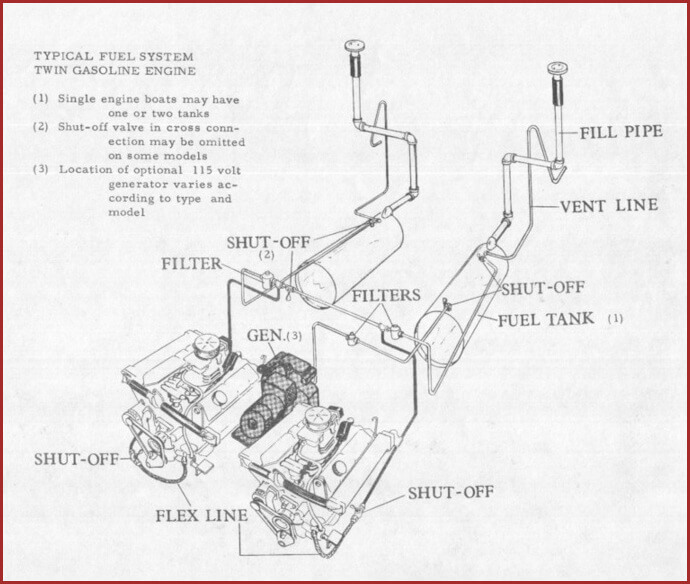FUELING INSTRUCTIONS
The following instructions are quoted from U.S. Coast Guard CG - 395.
l. Avoid fueling at night except in emergencies.
2. When moored at fueling pier:
A. Do not smoke, strike matches or throw switches.
B. Stop all engines, motors, fans and devices liable to omduce sparks.
C. Put out all lights and galley fires.
3. Before starting to fuel:
A. See that boat is moored securely.
B. Close all ports. windows, doors and hatches.
C. Ascertain how much additional fuel is needed, 1to avoid overflow.
4. During fueling:
A. Keep nozzle in contact with fill opening to guard against possible static spark.
B. See that no fuel spills get into hull or bilges.
5. After fueling:
A. Replace fill caps.
B. Wipe up ALL spilled fuel.
C. Open all ports, windows, doors and hatches.
D. Permit boat to ventilate for at least five minutes.
E. See that there is no odor of gasoline in the engine room or below decks before starting machinery or lighting fires.
F. Be prepared to cast off moorings as soon as engines are started.
NOTE: Use bilge blower for positive ventilation after fueling, but do not start any other equipment until certain that the boat is free of funes. In addition, we recommend that refueling be considered an emergency operation, and that the owner establish his own rules, including:
1. Generator switch in "
OFF" position.
2. Reduce the number of people on board to the minimum when fueling before taking passengers aboard, or by discharging passengers before proceeding to the fueling pier.
3. Keep everyone on the alert by assigning each person to a specific station, such as manning fire extinguishers, mooring lines, etc.
4. Permit no unnecessary conversation, noise or skylarking on board during the fueling operation.
FUELING SYSTEMS
Trojan's fuel systems are designed to meet or exceed all requirements of the U.S. Coast Guard, National Fire Protection Association, and the American Boat and Yacht Council in effect at time of manufacture.
The fuel system on your Trojan Motor Boat is certified to be air tight, leak proof and safe to use at the time of manufacture. It is the responsibility of the purchaser to maintain it in that condition by avoiding the storage or handling of gear that might damage or obstruct the fuel lines, valves and fittings, and by making frequent inspections to assure that no deterioration or loosening of joints is resulting from vibration and possible careless foot traffic. This is extremely important because practically all boat fires are started by gas fumes ignited by a spark.
Any odor of gasoline must of course be immediately investigated and steps taken to protect the boat and its occupants until the problem is corrected. A fume detector in good working order is a more reliable alarm, but even it should not be relied upon for safety -- it can only serve as a warning that a potentially hazardous condition already exists.
The prudent Skipper will take comfort only in the certain knowledge that his fuel and electrical systems are at all times maintained in sound condition. He can then relax and enjoy his boat in safety and comfort.
The accompanying sketch shows the lay-out of a typical twin gas engine fuel system. On diesel boats the general layout is similar, but return lines from the fuel pumps to the tanks are required.
A fuel filter is provided in each suction line, in addition to the engine filter. Filters should be cleaned frequently to assure an adequate supply of clean, dry fuel to the engines.


